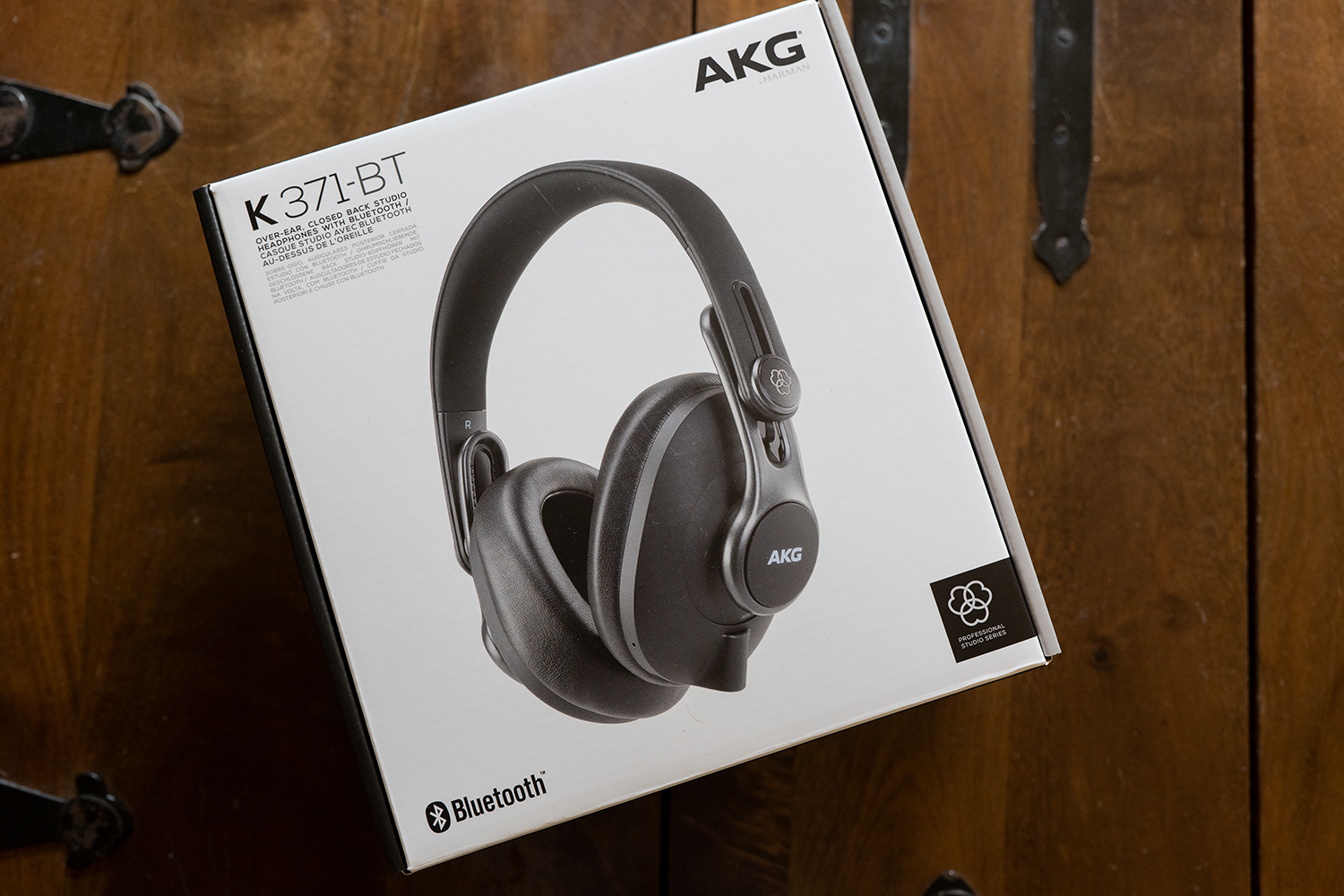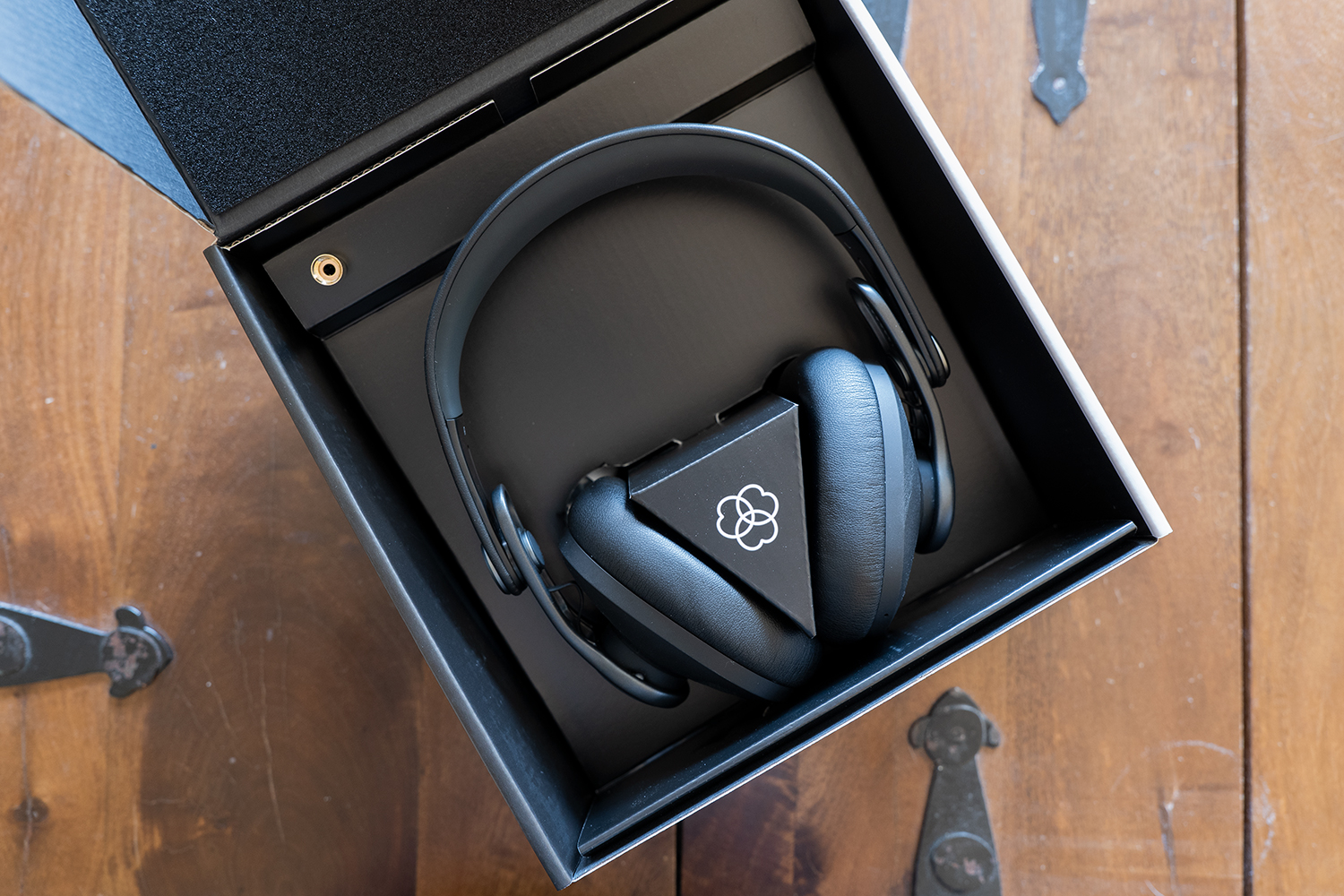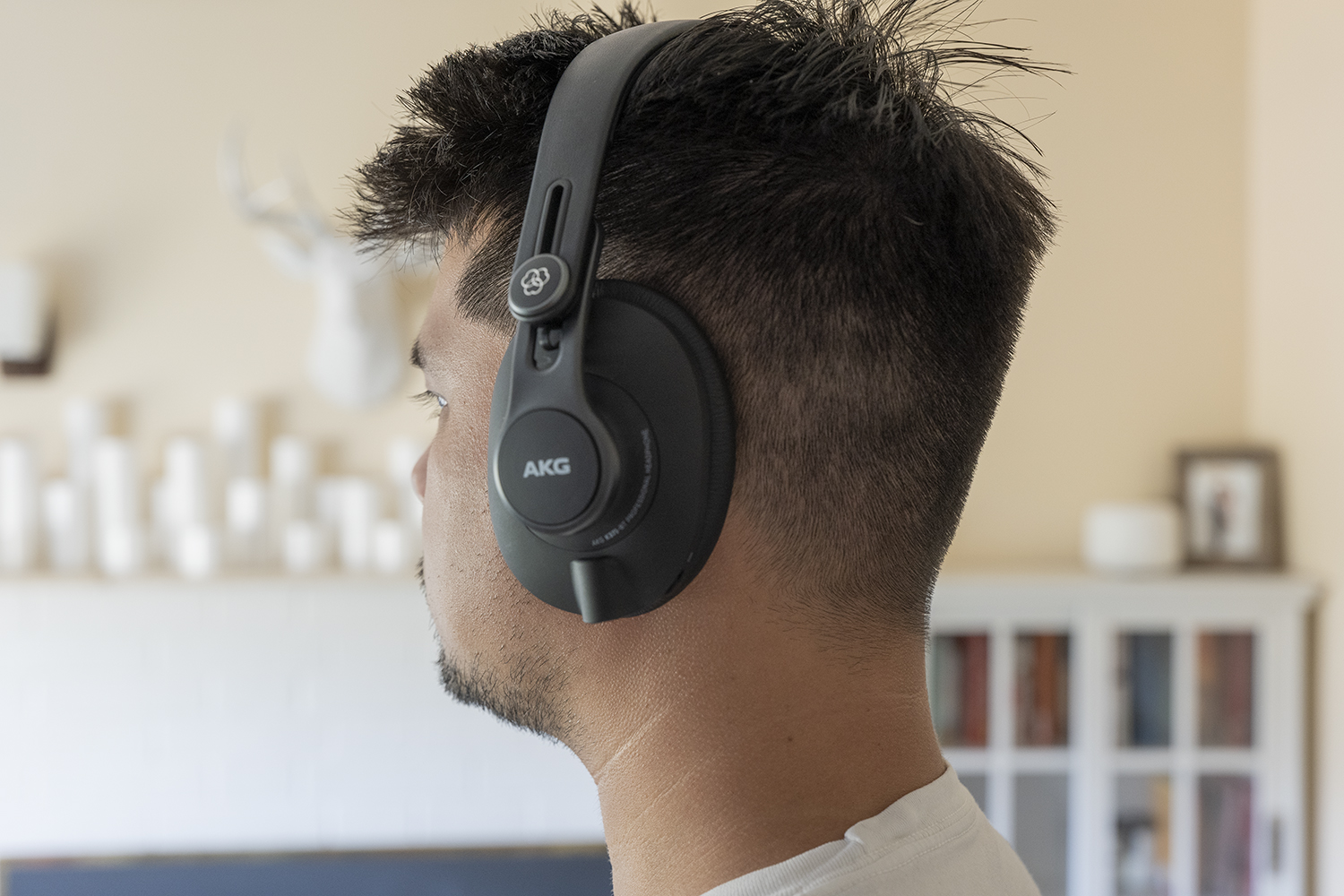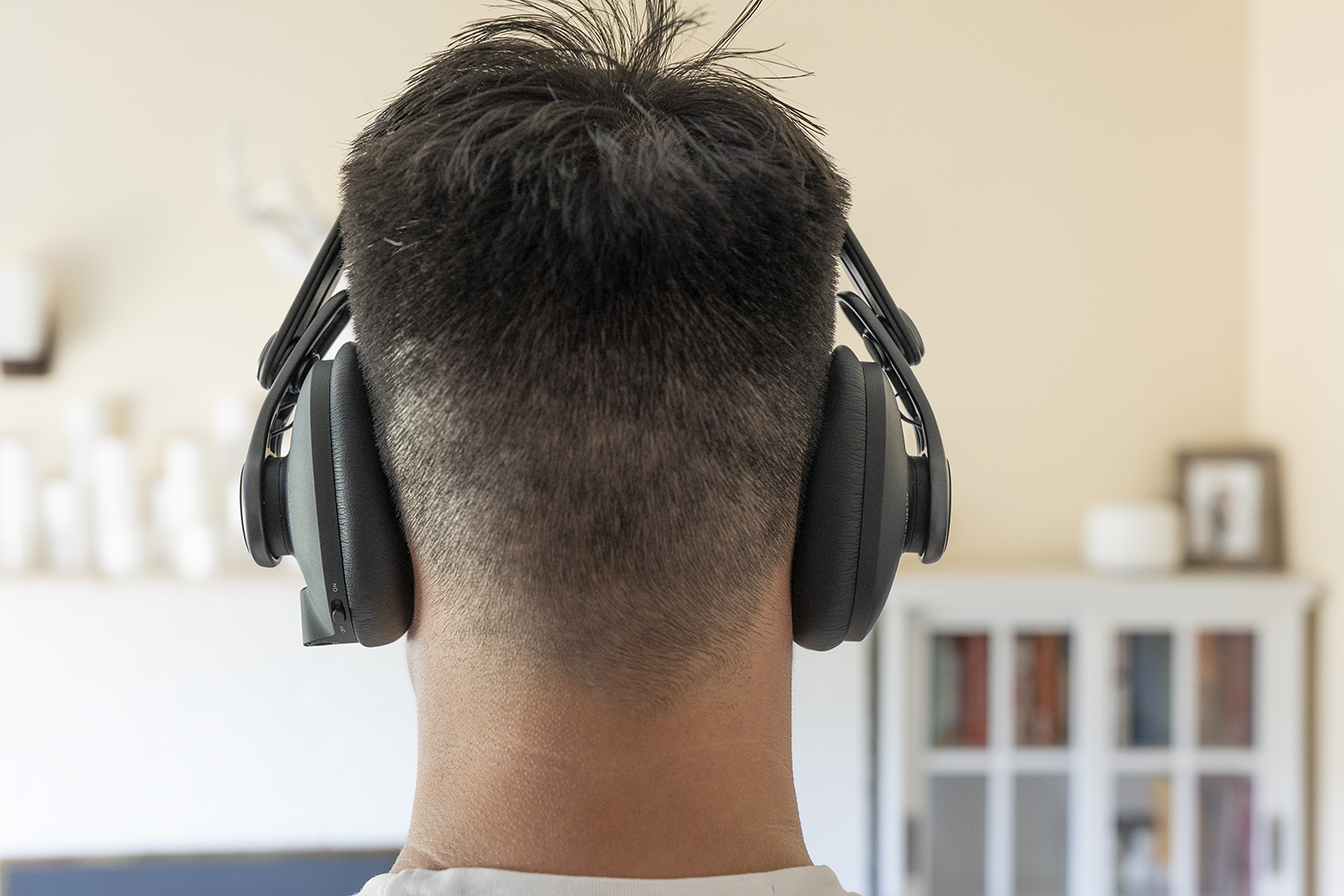
“The K371-BTs are portable, detail-focused cans that do justice to the AKG heritage.”
- Excellent critical detail reproduction
- Nice folding design
- Quality touch controls
- Good battery life
- Uneven pressure can lead to fatigue
- Weak bass
AKG’s heritage is in studio environments where musicians are looking for strong performance out of their critical-listening cans. As such, AKG makes some of the best detail-oriented studio headphones on the market, which are prized by recording artists specifically. Those headphones, however, are not only very expensive but also not tailored to everyday use.
The AKG K371-BT fill that void as a portable set of studio monitors that are also relatively inexpensive. They come in at an approachable $180, and though they do not offer active noise cancellation, the look to take AKG’s heritage on the go.
So how are they? Let’s dig into it.
Simple, straightforward packaging
The K371-BTs ship in a simple, light cardboard box that is assuredly recyclable given that it has no thick coatings or textures. That means the presentation is not all that impressive, but I think I care more about being able to responsibly dispose of a box than I do about reveling in how it looks and feels.
The headphones ship with a soft carry case, a USB-C to USB-A charging cable, and three (!) aux cables — coiled, short straight, and long straight — for a hard line into a computer or soundboard. They even ship with a plug adapter from 3.5mm to ¼-inch, just like dedicated studio monitors. On the other end that connects to the headphones, it almost looks like a mini-XLR. It’s a huge port, and I couldn’t find any information from AKG as to why it went with this one, but it might be why the sound quality improves dramatically when you plug in rather than rely on Bluetooth — more on that later.
The three different cables included is a first for me, and I did not think I would appreciate them as much as I do. I’m usually a fan of the coiled cable, but due to the construction of the connection port (more on that later), I actually came to prefer the long straight cable. I like that I was given a choice.

Many companies don’t put a lot of effort into the carry case (some don’t even include one at all), but the AKG soft carry case isn’t phoned in one bit. I like it a lot. The exterior is a kind of rough, tough sewn nylon, while the interior is a soft velvet-like material that feels like a great home for the headphones to reside. It’s still a soft case, so any protection it could provide is minimal, but at least it looks and feels nice.

Features
The AKG K371-BTs are short on tangible features. They don’t have active noise cancellation or Bluetooth multipoint, nor do they have any integration with a smart assistant. The focus is instead on sound quality and usability.
As far as usability goes, the only visible button/switch on the headphones is located on the left earcup and is used to turn the headset on and off. When connected, a small LED inside the switch will glow blue. It will turn white (and blink) when the battery level is low and remain a steady white when it is charging, then turn off entirely when the battery is fully charged.

To control music, the left earcup has a touch-sensitive pad that feels identical to the non-touch-sensitive pad on the right earcup – it’s a seamless implementation. The pad is sensitive to swipes and a double-tap: Swiping up or down will raise and lower volume, swiping forward or backward will skip forward or backward, and double-tapping the pad will pause or play music. I’ve used many different touchpads on headphones, and the implementation here is among the best. Because the pad itself is relatively small and easy to recognize by feel, it isn’t often that I don’t get the desired response out of a touch command. Overall, it works great.
I’ve used many different touchpads on headphones, and the implementation here is among the best.
The K371-BTs work for calls as well, thanks to a small microphone on the left earcup that’s situated in front of the charging port and slightly forward on the headset, making it able to better pick up your voice. There’s more on the quality of those calls below.
The battery life on these cans is very good at 40 hours per charge. It’s not the best on the market for a non-noise-canceling headset (that award goes to the Jabra Elite 45h, which get a stunning 50 hours), but it’s solid.
They, unfortunately, do not seem to have a quick-charge feature but will charge fully from empty in two hours.
AKG does have a headphone app, but confusingly not all its wireless products are supported by it, and that includes the K371-BTs. It is very surprising to me to see inconsistent app support from a brand like AKG, and not having the ability to adjust the EQ on these headphones is an unfortunate negative that we’ll get into below.
Fit and comfort
I have to say that, unfortunately, the AKG K371-BTs are not the most comfortable headphones I’ve tested. They collapse in on themselves for easy storage at a joint that also determines the snugness of the fit, and that joint results in a wonky fit when they’re over my ears. It’s hard to explain, but it feels like the bottom of the cup isn’t as snug against my head as the top is, leading to a feeling that the pressure is more extreme at the top of the cup. This lopsided fit quickly leads to fatigue when I wear them.

I really do like how the headphones collapse, though. The way AKG chose to make them fold up and into themselves feels like a design that will put less physical stress on joints and result in a headset that will last a long time.
Unfortunately, the AKG K371-BTs are not the most comfortable headphones I’ve tested.
The earcups are a leather-like material that feels pretty run-of-the-mill but isn’t bad by any means. For the price AKG is asking, they’re just supple and soft enough to meet my expectations. Likewise, the cushion on the headband is made of air-filled silicon and is moderately comfortable. Nothing to write home about, but no major complaints either.
I mentioned earlier that I appreciated the multiple cable options because I ended up not liking the coiled cable I generally select for my headphones. That’s because the giant port that AKG chose for the connection point to the
Studio-quality audio
For those who have worked in music, or even video, editing, you know that having solid, neutral headphones with excellent treble clarity is a must. If that is what you went into the AKGs expecting, that’s what you’re going to get. These are wireless studio monitors, and you get everything you expect from that name with the K371-BTs. So while you get that super-clear sound that’s great for critical listening, you also have a situation where the bass presence isn’t particularly powerful.
The K371-BTs are at their strongest with vocals. Podcasts, voices in movies, and lyricist-forward music is where these headphones will wow you the most. Voices are incredibly clear and crisp without becoming icy or sharp, a sign of high-quality, well-tuned drivers. If you’re like me and love listening to lyricists’ vocal tones more than the words they’re saying, then you likely will be quite pleased with what the K371-BTs offer.
The vocals of you! by Lany, as well as Oxygen by RØMANS, come through beautifully on the K371-BTs, with the details of their pitch and cadence crystal clear, while the tone is soul-touching in quality.
You get solid performance via Bluetooth, but since they only support AAC and SBC codecs, these headphones really break out of their shell when you connect with one of the three included cables. I enjoy the freedom that Bluetooth affords, but if you wanted to, you could plug these in while working in a sound studio and be very pleased with the fidelity they can provide. Wired listening is a big boost in quality over Bluetooth, especially if you’re listening to high-fidelity audio sources like a Tidal Mastes track. They’re not going to match the best AKG makes and are not quite as good as the V-MODA M-200, Grado, or Audeze wired
The critical listening chops… are on full display here.
As I mentioned, though, like many pure studio monitors, the bass output on the K371-BTs is pretty low. The lower registers are absolutely there for you to hear, they just are presented with a flat EQ, equal in strength to the mids and highs. For audio work, this is great, but for casual listening, I really like to hear more oomph. Since there is no way to adjust the EQ, that limits who will really like these headphones.

In Avengers: Endgame, the final cinematic battle sequence rings hollow compared to its reproduction out of other audio equipment. That said, the K371-BTs stepped up when Sam (Falcon) talks to Steve Rogers (Captain America) through his earpiece just before the Avengers assemble scene. It was shockingly clear — clearer than I can recall ever hearing it. The critical listening chops I mentioned are on full display here. And for what it’s worth, despite missing that bass, the headphones still managed to make me tingle with excitement while watching all those heroes line up.
Call quality
The microphone on the K371-BTs is good enough, but it’s nothing to write home about. Your voice can at times sound far away, but it’s generally pretty clear and adequate. On the other end, you’ll have no issue hearing calls, as the headphones do a good job with noise isolation.
Weirdly, the touch controls don’t support answering or hanging up a call. I can’t imagine it would have been that hard to just map it to the same gesture as pausing and playing a song, but with the K371-BTs, you’ll just have to make do with using your phone for call control.
Our take
I personally really enjoy studio monitors when I’m working, and value the critical detail that these headphones can provide. Unfortunately, I think many folks who would otherwise love these
Are there better alternatives?
The $180 price point is a good one, as it comes just below many other great options competing at $200, like The Skullcandy Crusher Evo which have considerably more bass. The Sony WH-CH710N are also a solid pick, as are the Jabra 85H, which can be found on sale for $200 now. Finally, Sennheiser’s very good HD 450BTs can be had for as low as $150 and are a good set of cans.
How long will they last?
These headphones are built well and shouldn’t break any time soon. Thanks to the option to physically plug them into your computer, even if the battery dies at some point, they will continue to be useful. Additionally, they are covered by a one-year manufacturer’s warranty.
Should you buy them?
Yes, if you are looking for a pair of versatile studio monitors. They’re not the best Bluetooth headphones you can get, and they also aren’t the best studio







